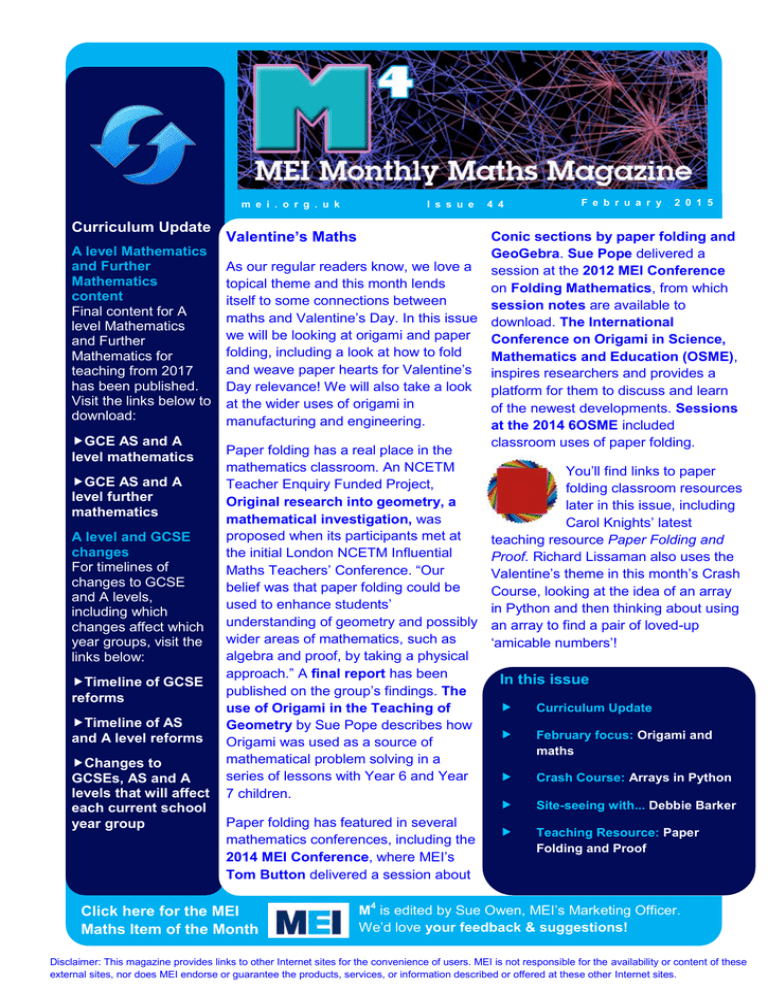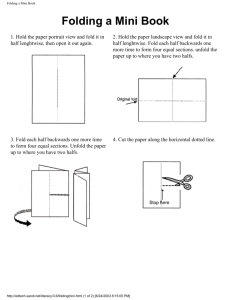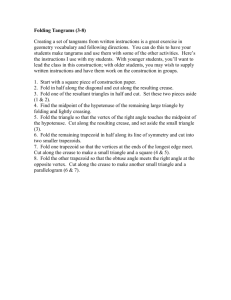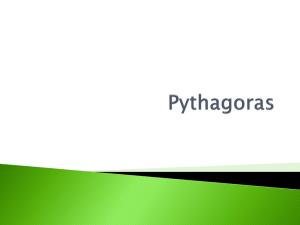Curriculum Update Valentine’s Maths
advertisement

m e i . o r g . u k Curriculum Update A level Mathematics and Further Mathematics content Final content for A level Mathematics and Further Mathematics for teaching from 2017 has been published. Visit the links below to download: GCE AS and A level mathematics GCE AS and A level further mathematics A level and GCSE changes For timelines of changes to GCSE and A levels, including which changes affect which year groups, visit the links below: Timeline of GCSE reforms Timeline of AS and A level reforms Changes to GCSEs, AS and A levels that will affect each current school year group I s s u e 4 4 F e b r u a r y 2 0 1 5 Valentine’s Maths Conic sections by paper folding and GeoGebra. Sue Pope delivered a As our regular readers know, we love a session at the 2012 MEI Conference topical theme and this month lends on Folding Mathematics, from which itself to some connections between session notes are available to maths and Valentine’s Day. In this issue download. The International we will be looking at origami and paper Conference on Origami in Science, folding, including a look at how to fold Mathematics and Education (OSME), and weave paper hearts for Valentine’s inspires researchers and provides a Day relevance! We will also take a look platform for them to discuss and learn at the wider uses of origami in of the newest developments. Sessions manufacturing and engineering. at the 2014 6OSME included classroom uses of paper folding. Paper folding has a real place in the mathematics classroom. An NCETM You’ll find links to paper Teacher Enquiry Funded Project, folding classroom resources Original research into geometry, a later in this issue, including mathematical investigation, was Carol Knights’ latest proposed when its participants met at teaching resource Paper Folding and the initial London NCETM Influential Proof. Richard Lissaman also uses the Maths Teachers’ Conference. “Our Valentine’s theme in this month’s Crash belief was that paper folding could be Course, looking at the idea of an array used to enhance students’ in Python and then thinking about using understanding of geometry and possibly an array to find a pair of loved-up wider areas of mathematics, such as ‘amicable numbers’! algebra and proof, by taking a physical approach.” A final report has been In this issue published on the group’s findings. The Curriculum Update use of Origami in the Teaching of Geometry by Sue Pope describes how February focus: Origami and Origami was used as a source of maths mathematical problem solving in a series of lessons with Year 6 and Year Crash Course: Arrays in Python 7 children. Site-seeing with... Debbie Barker Paper folding has featured in several Teaching Resource: Paper mathematics conferences, including the Folding and Proof 2014 MEI Conference, where MEI’s Tom Button delivered a session about Click here for the MEI Maths Item of the Month M4 is edited by Sue Owen, MEI’s Marketing Officer. We’d love your feedback & suggestions! Disclaimer: This magazine provides links to other Internet sites for the convenience of users. MEI is not responsible for the availability or content of these external sites, nor does MEI endorse or guarantee the products, services, or information described or offered at these other Internet sites. Paper folding in the maths classroom Origami hearts Easy Heart Getting started with paper folding in the maths classroom Resources from the British Origami Society Origami Club has a printable resource that takes step by step you through the process of folding a paper heart, as well as an animation that you can view at various speeds. Check Heart By using paper that is coloured on one side, you can fold a heart with a checked pattern on it. This helpful animation can be viewed at slow speed. There are many more Valentine’s origami patterns and animations on the same site, along with folded shapes, numbers and maths symbols. Folding angles of 45 and 90 degrees Nick Robinson shows one of the many methods of creating angles of 45 and 90, with non-raw sides. This design can be used to teach many things; accuracy, geometry, folding techniques, combining polygons and will serve practically as either a bookmark or a setsquare. Folding angles of 30 and 60 degrees Ian Harrison’s method of constructing angles of 60ºand 30º by folding is based on the symmetry of an equilateral triangle - one that has three edges of equal length. Folding optimal polygons David Dureisseix looks at various ways of folding the "optimal" pentagon & hexagon (the largest regular hexagon within a square of paper). Other resources include: Fujimoto and Fuse twist boxes If you would like some hands on origami practice, the British Origami Society is holding its convention in March in Birmingham. You can read about the experiences of a previous novice attendee in this New Scientist article. Ian Short’s nrich article Paper Folding - Models of the Platonic Solids describes how to build models of the Platonic solids using sheets of paper. A resource with nets and animations is available from Maths Is Fun. Mathigon is a visually stunning interactive site for teachers and students, with a section about Mathematical Origami: “Explore the beautiful world of Origami and Mathematics – from Platonic and Archimedean solids to stars and compounds. Containing stunning photographs, folding instructions and mathematical explanations.” Although the article is aimed at younger students, the section Ten Teaching Techniques in The Japan Society’s Origami in the Classroom: Where Every Child Counts! is useful for all age groups. Further reading about paper folding in the classroom: Origami: mathematics in creasing Mathematics of paper folding The Miura-Ori map Origami Origami and Math Mathematical Art Galleries Paper folding on a larger scale Woven paper hearts Although these are really intended as Christmas decorations in Sweden, these paper heart baskets would work well for Valentine’s Day. Instructions and templates can be downloaded from Mirkwood Designs. There is also a YouTube video demonstration that may help to guide you through the weaving process. Triaxial Heart Once you’ve got the hang of the weaving technique, here’s a more challenging Triaxial Heart from papermatrix to try. Fractal sponges Crowdsourcing Origami Sculptures, a 2014 6OSME abstract, looks at projects where volunteers worked collaboratively to build very large origami sculptures by linking thousands of traditional business card cubes, such as the fractal sponges built in last year’s MegaMenger: “The MegaMenger may be the largest fractal ever built, made out of over a million business cards and encompassing the entire Earth.” Although MegaMenger is now complete, the MegaMenger website has some instructions and printable PDFs you can use to print some fractal cards. See also Wired.com’s article about the Snowflake Sponge designed by MIT-trained engineer Dr. Jeannine Mosely. Engineering in Origami Robert Lang is one of the best origamists of the modern times. He uses mathematics and engineering principles to fold intricate designs. In his highly recommended Ted Talk The Math and Magic of Origami, not only does Lang give a fascinating insight into the history of origami, and how it has developed with the application of mathematics. He describes the principles of crease patterns used in origami. Lang’s illustrations of models created from hundreds of folds using a single piece of paper are quite amazing! Lang explains how to break down the process of folding the paper into a simple step by step process. He developed a free computer program called TreeMaker that calculates the crease pattern from a simple stick figure. He also explains how the principles of origami can be employed in other uses beyond the aesthetic: “Surprisingly, origami and the structures that we've developed in origami turn out to have applications in medicine, in science, in space, in the body, consumer electronics and more.” Lang goes on to talk about some of these applications. Origami in Engineering As the Engineering Council says, “To most people origami purely means the art of folding paper. However, today's engineers are using this ancient oriental technique to help solve some of the world's great challenges.” Here are links to just two examples: A solar array that can be tightly compacted for launch and then deployed in space to generate power for space stations or satellites A complex folding pattern of 28 creases that form the design for a rigid bag with a closed bottom Crash Course: Arrays in Python A maths and computing puzzle column written by Richard Lissaman This column provides an introduction to the programming language Python using maths puzzles as motivation to learn code! In this month’s Valentine’s day special we’ll look at the idea of an array in Python and then think about using an array to find a pair of lovedup ‘amicable numbers’! The task An array is just a list of numbers in a particular order. Python commands creating arrays and operating on arrays are shown on the left of the screen grab opposite. Try entering the code (see right) in the Codecademy Python workspace and running it for yourself. Crash Course icon: Cropped from original Python wallpaper by Cazembe used under CC BY 1) In the first line we are declaring our list or array. We have called it myarray. At the moment it is empty, it is a list of precisely no things! 2) In these lines we add the numbers 10 and 20 to our list. So after myarray.append(10) our list is just the number 10 and then after myarray.append(20) our list becomes 10, 20. The order is important here, every time we append a number it gets put on the end of our current list. 3) Here we can see how to refer to things in myarray. The number in the very first position of myarray is referred to as myarray[0]. So the first number is in the zeroth position! This is a common convention in computing and even in mathematics where you might see the first term of a sequence given the name x0. The second number in our list is called myarray[1]. 4) Now we join on the numbers 30, 40, 50, 60, 70, 80, 90, 100 to our array using a for loop (see the last column for more about loops). Finally we print out all the things in our myarray list. There are lots of other commands for interacting with arrays. You can read about them here. Now we’re going to get Python to help us find a pair of amicable numbers. Amicable numbers are two different positive integers so that the sum of the proper divisors of each is equal to the other. We could ask whether 12 and 20 are a pair of amicable numbers? The sum of the proper divisors of 12 is 1 + 2 + 3 + 4 + 6 = 16. This is not equal to 20… The sum of the proper divisors of 20 is 1 + 2 + 4 + 5 + 10 = 22. T This is not equal to 12… So 12 and 20 are not a pair of amicable numbers… (Cont on next page) Crash Course: Python challenges Amicable Numbers However there is a pair of amicable numbers n, m in which n and m are both less You might like to look at these resources after trying this month’s problem: than 300. Let’s use Python to find them! The code below is one way to set about this: Valentine’s Day: Amicable Numbers Amicable Numbers video Friendly Number Friendly Numbers, Solitary Numbers, Perfect Numbers Friendly Number Perfect, Friendly, and Amicable numbers If you run this code there will be no output but try to work out what it does: First a function called sumoffactors is defined. To understand this function you need to know that int(n/2) is the largest integer less than or equal to n/2. So int(2.8) = 2. This function has a return command. This means that once the function has done its work it will send back a value, in this case the value of the variable total. So sumoffactors(10) is the value of total if the function is run with n = 10. Can you see that sumoffactors(10) will be the sum of the proper divisors of 10? Then an array is created called sumfactorsarray. The first two numbers in the array are set to be 0 and 1. After that the for loop then adds the sums of all the proper factors of the numbers from 2 to 300 inclusive. This means that sumfactorsarray(20) is the sum of all the proper factors of 20 and sumfactorsarray(233) is the sum of all the proper factors of 233. Problem of the month Can you, in Python, add to the code above to check sumfactorsarray to find the pair of amicable numbers n, m in which n and m are both less than 300 and print them to the screen? The solution is available to download from the Monthly Maths web page. Site seeing with… Debbie Barker Each month a different member of MEI staff will share a couple of their favourite resources it might be some software, a website, a printable download, a book, etc. As part of the online element of the Teaching GCSE Mathematics (TGM) course we have been looking at Transformations this month. I start by sharing one of my favourite starters, Mobius Transformations Revealed. The column is intended to be a quick read - but we’d love to hear from you if you’d like to give feedback or tell us how you used the I like its gentle style and I like how resources. students react to the simplicity, the music and the surprises. The pace This month’s resources are shared means that students have time to jot down their responses on mini by Debbie Barker, whiteboards to whatever prompts you the MEI Coordinator for CPD in teaching provide: at Key Stage 3 and Which transformations do you Key Stage 4. recognise? What mathematical terms are you Debbie designs and manages MEI’s reminded of? Teaching GCSE What questions do you have? Mathematics (TGM) course. I think it sets the scene brilliantly for an approach to transformations of “Here’s the change, how can we mathematise it?” I seek to provide a situation where students experience the need for a description, consider possible solutions and to wonder what the conventions might be. As an example, here is a GeoGebra activity for starting to think about enlargements. Students are able to move the point and the slider and are asked to reproduce the following pictures on their screen (both the point and slider are invisible in these target pictures): Typical classroom dialogue would follow along the lines of: The point is important; it’s called the centre of enlargement. What do we need to know about the centre of enlargement? How might we describe that information? The slider is important too... In my experience, many students start to ask questions associated with the slider taking values other than positive integers… A happy ending? Parametric Heart Spreadsheet The Stable Marriage Problem Do you ever wish your spreadsheets were more romantic? This resource from Think Maths will help to make them so! “Using parametric equations, you can construct a perfect heart shape, and this Excel file has everything you need to understand how the equations give the shape, as well as allowing you to edit the parameters and see how that changes the resulting plot. “There's also a second sheet with the equations for a cardioid. The spreadsheet can be given to students directly, or kept as a cheat-sheet while they make their own. “Great as part of a lesson on parametric equations, or just a fun activity to play around with.” In this Numberphile video, Dr Emily Riehl asks if you should accept a marriage proposal or keep waiting for a better offer? Men and women are asked to compile a list of four prospective suitors, in order of preference. She explains how an algorithm will find a solution to the problem of finding the suitors most likely to result in stable marriages for all – a process of tentative engagements that can be broken as prospective suitors find a better choice. Once everyone is engaged, some to their first choice and some to their fourth, this provides the solution to a stable marriage. The Happy Ending Problem In another Numberphile video, Prof Ron Graham looks at convex polygons – how many points must your put on a piece of paper (without any three being in a straight line) to guarantee a convex polygon of a set number of sides (an n-gon)? The conjecture is shown opposite. It has been proved for n=4, n=5 and n=6. New classroom resource In the following pages is a teaching and learning resource: Paper Folding and Proof, developed by Carol Knights, MEI Extension and Enrichment Coordinator. The PowerPoint can be downloaded from the MEI Monthly Maths Magazine web page. This month’s edition has 4 activities which link paper folding and proof. These support the development of reasoning, justification and proof: a renewed priority within the new National Curriculum. They are presented in approximate order of difficulty. Square Folds For each of these challenges, start with a square of paper. 1. Fold the square so that you have a square that has a quarter of the original area. How do you know this is a quarter? Square Folds 2. Fold the square so that you have a triangle that is a quarter of the original area. How do you know this is a quarter? 3. Can you find a completely different triangle which has a quarter of the area of the original square? Square Folds 4. Fold to obtain a square which has half the original area. How do you know it is half the area? 5. Can you find another way to do it? Pythagoras Unfolded Start with a square of paper. Put a dot a short distance from one vertex - about a third of the side length works well, not too close as you’re going to have to fold from it. Put dots exactly the same distance from the other vertices, working around the square as shown. Pythagoras Unfolded Fold to join the dots as shown. What shape is this? How do you know? Pythagoras Unfolded Mark three other dots as shown, using the same distance as you used for the previous ones. Pythagoras Unfolded Create folds as shown. Notice that two of the folds don’t go all the way across. It’s easiest if you do the vertical one first as this gives the guide line for where to finish the other folds. Pythagoras Unfolded For the next slides, locate the relevant lengths or shapes on your folded square. Pythagoras Unfolded a Pythagoras Unfolded b Pythagoras Unfolded c Pythagoras Unfolded What are the dimensions of this triangle? Pythagoras Unfolded What is this area? c2 Pythagoras Unfolded What is this area? a2+b2 Pythagoras Unfolded Explain what this sequence of diagrams shows: Thinking about how you folded the shapes, can you explain why the yellow and green triangles will fit as shown? Pythagoras Unfolded Can you now link it all together and explain how this is a proof of Pythagoras’ Theorem? This proof started with a square in which you created triangles in a certain way; would it work for any right-angled triangle? Equilateral Triangle Start with a piece of A4 paper. Fold as shown. Equilateral Triangle Pick up the bottom left hand vertex and fold so that the vertex touches the centre line and the fold being made goes through the top left vertex. Equilateral Triangle Pick up the bottom right hand vertex and fold so that the fold being made lines up with the edge of the paper already folded over. Equilateral Triangle Finally, fold over the top as shown. Folding away from you helps keep the triangle together. Equilateral Triangle This looks like an equilateral triangle, but how can we be sure that it is? Unfolding the shape gives us lots of lines to work with, but all we really need is the first couple of folds. It may help to start with a fresh piece of paper and simply make these two folds. Equilateral Triangle Drawing round these edges will also be helpful. This is what you should have. What can you work out? Equilateral Triangle Hint #1 The triangle is created as shown; we need to show that 2 of its angles are 60° Equilateral Triangle Hint #2 Can you find the angles in this triangle? Equilateral Triangle Hint #3 Think of the length of the short edge as 2x. Equilateral Triangle Hint #4 When you fold the vertex in, what distance is shown? Equilateral Triangle Hint #5 What dimensions of this triangle do you know? Equilateral Triangle Hint #6 The fold line is a line of symmetry of the grey shape. Regular Pentagon Start with a piece of A4 paper. Put two diagonally opposite vertices together and fold as shown. Regular Pentagon Turn the shape clockwise so that it looks like this: Regular Pentagon Crease along the line of symmetry, then open it back out. Regular Pentagon Fold so that the red edge meets and aligns with the red fold. Regular Pentagon Fold the other side (marked in red) in a similar way. Regular Pentagon This looks like a regular pentagon, but how can we be sure that it is? Folding can be inaccurate, but with mathematics we can prove whether it is regular or not. Regular Pentagon Unfolding the shape gives us lots of lines to work with, but all we really need is the first fold. It may help to start with a fresh piece of paper and simply make the first fold. Regular Pentagon You need to know that the dimensions of a piece of A4 paper are 297mm by 210mm. What is the size of the internal angle of a regular pentagon? Can you work out the size of the angle at the top of the shape? Regular Pentagon Hint #1 The top angle is made up of two smaller angles. Find out what these are and add them together. Regular Pentagon Hint #2 Draw this line on before opening it out Regular Pentagon Hint #3 Regular Pentagon Hint #4 Why are these the same length? Teacher notes: Paper Folding This month’s edition has 4 activities which link paper folding and proof. These support the development of reasoning, justification and proof: a renewed priority within the new National Curriculum. They are presented in approximate order of difficulty. Discussion and collaboration are key in helping to develop students’ skills in communicating mathematics and engaging with others’ thinking, so paired or small group work is recommended for these activities. The first ‘Square Folds’ is suitable for many ages and abilities since a range of responses with different levels of sophistication are possible. The second activity looks at a paper-folding proof of Pythagoras. Teacher notes: Paper Folding The third and fourth activities require students to create specific common shapes and then prove whether or not they are regular. The third requires a knowledge of basic trigonometry, the fourth requires basic understanding of trigonometry and Pythagoras and the ability to expand brackets and solve linear equations (a quadratic term appears, but is balanced by an equivalent one on the other side of the equation). Hints are given, but it is helpful to allow students to grapple with the problems by not showing these too soon. Once a hint is given, it’s useful to wait a while before showing another. Discussion and explanaiton are key. One option is to print the hint slides out on card (2 or 4 to a sheet) and just give them to students as and when they need them rather than showing them to the whole class. Teacher notes: Square Folds There are a range of possible responses for each of these. One of the key concepts that can be developed through this activity is an appreciation of what is meant by proof. The progression through: • Convince yourself • Convince a friend • Convince your teacher is a good structure to use to encourage students to think about ‘why’ something is as they think it is, rather than just responding with ‘you can see that it is’. Demonstrating by folding to show that different sections are equal may be acceptable, or you may wish students to consider the dimensions of the shapes. Teacher notes: Square Folds Some possible answers: 1. A square, a quarter of the area. The lengths of the sides are ½ the original. 𝑥 𝑥 𝑥2 × = 2 2 4 2&3. A triangle, a quarter of the area. 1 𝑥 𝑥2 ×𝑥 = 2 2 4 Teacher notes: Square Folds 4&5 A square, half the area. Folding the vertices of the original square into the centre is one way to demonstrate that it is half the original area. Using Pythagoras theorem to show that the new square has side length √2 is also possible. This one is harder to justify. The diagonal of the new square is x. Using Pythagoras’ theorem, the side length of the square must be 𝑥 2 so the area is 𝑥2 2 Teacher notes: Pythagoras Unfolded Although it would be possible to skip straight to the diagrams, students having something they’ve folded in front of them helps them to see and understand exactly what’s going on. They can then annotate and/or colour the square and stick in their books or folders. Identify that the bottom triangle is a,b,c. Show that a2+b2=c2 The proof will work for any right-angled triangle. Create 4 copies of the required triangle and arrange them so that a ‘long’ and ‘short’ side form the edge of a square as shown (makes no difference which is short and which is long for isosceles triangles). Teacher notes: Equilateral Triangle Making the equilateral triangle is relatively straight-forward and can be used with all students during work with shape. Do they tessellate. Fold the vertices in to the centre to make a regular hexagon etc. The more challenging aspect of this activity is proving that it is indeed an equilateral triangle. Assuming the length of the blue side is 2x. The red line aligns with the blue side when the fold is made, so it is also 2x. In the right angled triangle shown, Opp is x and Hyp is 2x, therefore the angle shown is 30° Teacher notes: Equilateral Triangle Making the equilateral triangle is relatively straight-forward and can be used with all students during work with shape. Do they tessellate. Fold the vertices in to the centre to make a regular hexagon etc. The more challenging aspect of this activity is proving that it is indeed an equilateral triangle. Assuming the length of the blue side is 2x. The red line aligns with the blue side when the fold is made, so it is also 2x. In the right angled triangle shown, Opp is x and Hyp is 2x, therefore the angle shown is 30° and the other angle in the triangle must be 60° Teacher notes: Equilateral Triangle Looking at the grey kite, the fold line is a line of symmetry. This gives the angles shown. Since the angle sum of a quadrilateral is 360° the missing two angles must each be 60°. 30° 30° 30° 30° 60° ? 90° ? Teacher notes: Regular Pentagon The ‘top’ angle consists of a right angle and the angle shown. Since the interior angle of a pentagon is 108°, if the marked angle is 18° then it might be a regular pentagon, if it’s not 18° then it definitely isn’t regular. Teacher notes: Regular Pentagon The red line is created when the fold is made. Teacher notes: Regular Pentagon The dimensions of the triangle are as shown. Using Pythagoras’ theorem: (297-x)2 = 2102+x2 2972-594x+x2=x2+2102 594x =2972-2102 594x = 44109 x= 74.26 Teacher notes: Regular Pentagon The dimensions of the triangle are as shown. Using trigonometry: 74.26 tan 𝜃 = 210 𝜃 = 19.47° This means that the top angle is 109.47°, so the pentagon is not regular… despite the title of the activity! Acknowledgements Ideas for ‘Square Folds’ from http://youcubed.stanford.edu/task/paperfolding-fun/ Images from: http://kimscrane.com/images/EF21K3.jpg http://www.muji.eu/images/products/l/4547315453153_l.jpg http://fc00.deviantart.net/fs71/i/2010/257/0/b/origami_paper_pattern_by _tseon-d2ypu5c.jpg Pythagoras activity from T. Sundara Row (1905) Geometric Exercises in Paper Folding.







